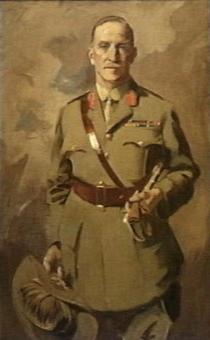This is an old revision of this page, as edited by Iain Stuart (talk | contribs) at 22:58, 2 April 2007. The present address (URL) is a permanent link to this revision, which may differ significantly from the current revision.
Revision as of 22:58, 2 April 2007 by Iain Stuart (talk | contribs)(diff) ← Previous revision | Latest revision (diff) | Newer revision → (diff)
General Sir Henry George 'Harry' Chauvel GCMG KCB (April 16, 1865 - March 4, 1945) was a general officer of the First Australian Imperial Force that fought during World War I. He is less well known than a contemporary, General John Monash, because he served in the Middle East theatre and not the well-documented theatre of the Western Front.
Chauvel became the first Australian to attain the rank of acting lieutenant general and the first to command a corps (the Desert Mounted Corps) when he was promoted after the reorganisation of the British army in Palestine following the disastrous Second Battle of Gaza.
Early life
Henry (Harry) George Chauvel was born in Tabulam, New South Wales on 16 April 1865 and was educated at Sydney Grammar before doing his final year at Toowoomba Grammar. He was commissioned into the Upper Clarence Light Horse, a NSW militia unit raised by his father, Major C. H. E. Chauvel, in 1886. Two years later the family moved to Queensland and he resigned his commission and took up one in the Queensland Mounted Infantry. In 1896, Chauvel transferred to the Queensland Permanent Forces with the rank of captain.
Boer War Service
Harry Chauvel commanded A Squadron of the Queensland Mounted Infantry in the Boer War, where he was mentioned in dispatches and was made a Companion of St Michael and St George (CMG). He returned to Australia to take command of the 7th Commonwealth Light Horse, which was to deploy to South Africa but did not get back to South Africa with it until after the war had ended.
Pre War Service
After the war Chauvel was promoted as brevet lieutenant-colonel and was posted as a staff officer with the Northern Rivers District near Townsville in Queensland. He was chief of staff there from 1904 to 1911, being promoted to lieutenant colonel in December 1909. Chauvel had served under Major-General Sir Edward Hutton, who was organising the new Australian Army, in South Africa. Hutton used Chauvel for a variety of tasks and this seems to have effected his career under Huttons Successor Major-General Hoad.
Based on his South African experience Chauvel developed views on the nature of mounted infantry and the need for Australian troops to improve their discipline in the field, better leadership from officers and better organisation for supply and medical evacuation.
On 16 June 1906, at All Saints Anglican Church, Brisbane, he had married Sibyl Campbell Keith Jopp; ultimately they had two sons and two daughters.
He was appointed to the Military Board (located in Melbourne) as Adjutant General in 1911, Chauvel was involved in the implementation of the compulsory training scheme. On 3 July 1914, Chauvel replaced Colonel J. G. Legge as the Australian representative on the Imperial General Staff in London, with the rank of full colonel, but the outbreak of war intervened.
War Service
While traveling to England with his family to take up his apointment World War One broke out. On his arrival in mid August 1914 Chauvel discovered a cable at the War Office appointing him to command the 1st Light Horse Brigade of the Australian Imperial Force (AIF). He remained in England however, because that was where the brigade was scheduled to train. While his brigade was en route to join him, Chauvel became convinced that the proposed camps on the Salisbury Plain would not be ready on time. He persuaded the High Commissioner in London, former Prime Minister Sir George Reid, to approach Lord Kitchener with an alternate plan of diverting the AIF to Egypt, which was done. Chauvel finally sailed for Egypt on 14 November 1914.
Trivia
His daughter Elyne Mitchell wrote a number of non-fiction works about her father and his corps. He is perhaps best-known for his successful attack on Beersheba (Bir Saba) on October 31, 1917. He had been unexpectedly ordered by General Edmund Allenby to take the town by the end of the day and Chauvel accomplished this. He sent the 4th and 12th Mounted Light Horse Regiments across 4 miles of open ground at the Turkish defensive trenches; they captured the town and its important wells.
His nephew Charles Chauvel was a well-known film director.
He was portrayed in the 1987 film The Lighthorsemen by Bill Kerr, which covered the exploits of an Australian cavalry regiment during the Third Battle of Gaza, and in the 1990 film A Dangerous Man: Lawrence After Arabia by Ray Edwards, which took place around the 1919 Paris peace conference. He was portrayed by Colin Baker in the 1992 Young Indiana Jones TV movie Daredevils of the Desert, another retelling of the Third Battle of Gaza from the director of The Lighthorsemen.
Reference
Hill, A.J. 1978 Chauvel of the Light Horse, Melbourne University Press
| Military offices | ||
|---|---|---|
| Preceded byCyril Brudenell White | Chief of the General Staff 1923-1930 |
Succeeded byWalter Adams Coxen |
This Australian biography article is a stub. You can help Misplaced Pages by expanding it. |